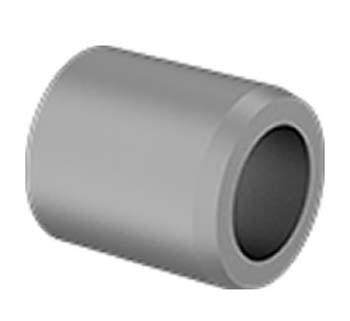Bushings and Hole Plugs
Bushings and hole plugs are vital components used in various industries to enhance the efficiency and performance of machinery and equipment. These unassuming devices serve crucial roles in reducing friction, isolating vibrations, preventing leaks, and protecting sensitive components. In this comprehensive product description, we will explore the world of bushings and hole plugs, their types, materials, applications, and how they contribute to seamless operations in diverse fields.
Bushings
What are Bushings?
Bushings, also known as plain bearings or sleeve bearings, are cylindrical devices designed to reduce friction between two moving parts. They act as a sliding surface, enabling relative motion while minimizing wear and tear. Bushings are typically made of durable materials like bronze, steel, or plastic, and they come in various shapes and sizes to accommodate different requirements.
Types of Bushings
- Plain Metal Bushings: These bushings consist of a solid metal sleeve, often made of bronze or steel, which provides excellent load-bearing capacity and durability. They are commonly used in heavy machinery, automotive applications, and industrial equipment.
- Flanged Bushings: Flanged bushings have an extended flange at one end, which helps in proper alignment and retention within the housing or mounting surface. They are suitable for applications where axial movement needs to be restricted.
- Thrust Washers: Thrust washers are flat, thin bushings used to support axial loads and facilitate smooth sliding motion between components in thrust applications.
- Self-Lubricating Bushings: These bushings are infused with solid lubricants like graphite or PTFE, eliminating the need for external lubrication. They offer low friction, high wear resistance, and are ideal for applications with limited maintenance access.
- Composite Bushings: Composite bushings combine different materials, such as steel-backed with a layer of PTFE, to achieve a balance of strength, lubricity, and cost-effectiveness.
Bushing Applications
Bushings find applications in a wide range of industries and machines, including:
- Automotive Industry: In suspension systems, steering columns, and engine components, bushings reduce vibration and noise while enhancing performance and longevity.
- Industrial Machinery: Bushings are integral to conveyor systems, pumps, electric motors, and other equipment, ensuring smooth and reliable operation.
- Aerospace: In aircraft landing gear, engine mounts, and control systems, bushings handle heavy loads and extreme environmental conditions.
- Appliances: Household appliances like washing machines and dishwashers utilize bushings to reduce noise and friction in rotating parts.
- Construction Equipment: Bushings are essential in construction machinery like excavators, bulldozers, and cranes, providing robust support and reducing component wear.
Hole Plugs
What are Hole Plugs?
Hole plugs, also known as access hole plugs or knockout plugs, are small, cap-like devices designed to fill or cover holes in various components or structures. They serve multiple purposes, such as preventing dust and debris from entering, sealing off unused openings, and acting as placeholders during manufacturing processes.
Types of Hole Plugs
- Snap-In Hole Plugs: These plugs have a tapered body that can be easily pressed into a hole, creating a secure and flush fit. They are commonly used in sheet metal applications and as finishing plugs in furniture.
- Threaded Hole Plugs: Threaded hole plugs have external threads that allow them to be screwed into threaded holes, providing a tight seal and secure fastening. They are suitable for both plastic and metal applications.
- Expansion Plugs: Also known as freeze plugs or rubber plugs, expansion plugs are designed to fit into a hole and expand, creating a tight seal without the need for additional fasteners.
- Flush-Mount Hole Plugs: Flush-mount plugs sit flush with the surface, providing a clean and aesthetically pleasing finish. They are commonly used in automotive body panels and furniture.
Hole Plug Applications
Hole plugs find widespread applications across various industries, including:
- Electronics: In electronic enclosures, hole plugs protect internal components from environmental elements and ensure safety.
- Automotive: Hole plugs are used in vehicle body panels and engine compartments to seal off unused holes and prevent corrosion.
- Furniture: In furniture manufacturing, hole plugs provide a finished look by covering exposed screw holes.
- HVAC Systems: Hole plugs are used in ductwork and ventilation systems to seal unused openings and improve system efficiency.
- Sheet Metal Fabrication: Hole plugs are essential in sheet metal applications to cover and protect holes created during manufacturing processes.
Materials for Bushings and Hole Plugs
The choice of materials for bushings and hole plugs is crucial to their performance and durability. Common materials include:
- Bronze: Bronze bushings offer excellent load-bearing capacity, wear resistance, and corrosion resistance. They are often used in heavy-duty applications.
- Steel: Steel bushings are known for their strength and durability, making them suitable for high-load and high-temperature environments.
- Plastics (Nylon, PTFE, Delrin): Plastic bushings and hole plugs are lightweight, self-lubricating, and resistant to chemicals and corrosion. They are ideal for applications where noise reduction and low friction are essential.
- Rubber: Rubber hole plugs offer flexibility and are commonly used as expansion plugs, providing a snug fit in various hole sizes.
Installation and Maintenance
Proper installation and maintenance are crucial for the optimal performance of bushings and hole plugs. Following manufacturer guidelines and ensuring the right fit are essential for long-term reliability.
Conclusion
In conclusion, bushings and hole plugs may seem like small components, but their impact on machinery and equipment is immense. From reducing friction and wear to providing efficient seals, these versatile devices contribute to seamless operations for many applications.










